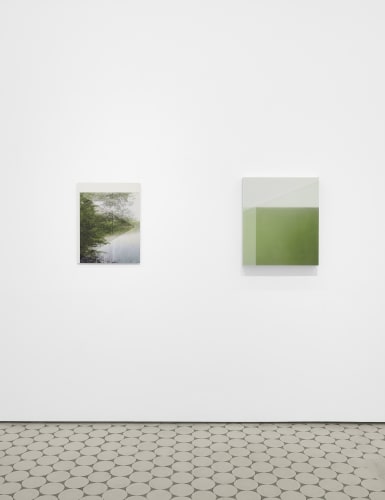Wentrup is pleased to present the third solo exhibition of Berlin-based photographer Miriam Böhm at the gallery.
e e e B n n N n: a sequence of individual letters that seduces us into wanting to create words. But even without forming a word, these letters have their own reality. This is also true for Miriam Böhm’s photographic oeuvre. Just as a word consists of individual letters, and a sentence of individual words, the artist constructs her photographs out of individual pictorial elements. These in turn are equally weighted elements within the picture that are positioned in relation to one another, and combined or superimposed in such a way that they are in equal measure motif, carrier of meaning, and visual content. From folded paper, cut cardboard, drawn lines or shadows, landscapes, textile, glass, structures, folds and creases, Böhm creates minimalist, formally emphatic compositions through which she thinks visually in different ways about space in the broadest sense. Böhm’s photographs emerge—using sometimes analog and sometimes digital technologies—somewhere on the contested field of plane, fragment, and space; between the poles of spatial design and intangible idea. They engage with visual shifts, fragments, and formal interventions. Exploring the visuality of her working material, and of making, as well as thinking about the possibilities of expanding her visual vocabulary, play a central role on Miriam Böhm’s photographic work. The issue for her is by no means the representation of reality; rather, her compositions make claims and create meaning poetically.
In terms of their presence, Böhm’s photographs remind us perhaps most of all of haiku, a traditional Japanese form of poetry that is considered the shortest poetic form. Haiku plays with rhetoric means, it has a pronounced inner rhythm, a strict form, and every word has a singular position—it stands for itself and is at the same time part of the structure and of a complex sentence. Haiku does not distinguish between the object of a word and its meaning. It is read in one breath. Due to the poem’s brevity, every single world has great significance, but the connection between the words is rather loose. At the end, the sentence fades away without a defined ending, floating in the air. Similarly, Miriam Böhm’s photographs in the end don’t want to be defined or legible down to the last detail. Rather, every work stands for itself as what it is: a picture. It represents something or expresses something that cannot be conceptually grasped.
In One (2019), the numbers 4 and 5 shine towards us in royal blue. They were superimposed on one another. Every number has its own meaning within the sign system, but Böhm dissolves this meaning by superimposing them on one another. In this way, she creates something new that does not have any meaning in the sign system we know, and cannot be defined linguistically. One claims to be something. The series Only (2020) is similar. Here, Böhm “only” takes out a piece from a sky shown on a piece of folded paper, and replaces it elsewhere, namely behind the framed photograph in the form of a wallpaper, with a new sky motif. A superimposition of two skies, with different coloring, photographed at different times, both of them not fully visible. It is these gaps, sometimes not visible at first, sometimes provocatively placed in the foreground, that interest Böhm and challenge our habits of perception.
Like in a poem, Miriam Böhm arranges in her exhibition e e e B n n N n abstract shapes next to landscape motifs, creates geometric forms from the silhouette of a mountain, causes cut cardboard pieces to float before a textile underground in impossible perspectives, or places papers on top of one another in such a way that their edges look like delicate pencil lines. Sometimes the photographs are framed, sometimes mounted on aluminum, sometimes realized as wallpaper. It is this interplay of forms that allows us to move through the exhibition rhythmically. Sometimes we pause because we want to get to the bottom of what we see. Wherever our thoughts may take us, directly in front of the works we become aware of the powerful silence the exude. A silence that allows us to become calm.

